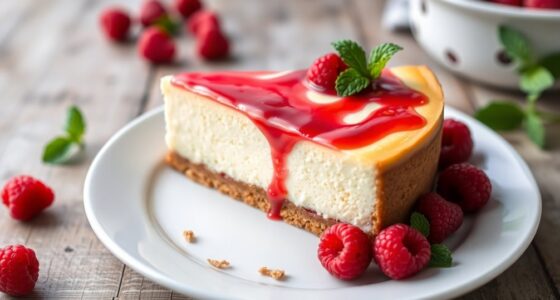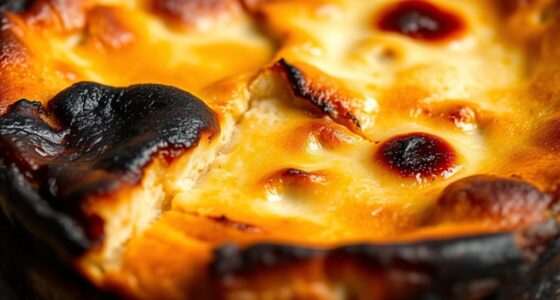Meringue is a versatile staple in many desserts, made by whipping egg whites with sugar and sometimes an acid. Soft meringue is light and airy, ideal for toppings or folded into fillings, while stiff meringue holds its shape for cookies or decorations. Swiss meringue, gently heated before whipping, is smooth, stable, and perfect for piping or finishing desserts. If you want to master these types, keep exploring the techniques and tips that make each one special.
Key Takeaways
- There are three main meringue types: French (basic), Swiss, and Italian, each with unique preparation methods and stability levels.
- French meringue is made by whipping raw egg whites with sugar, resulting in light, airy, but less stable foam.
- Swiss meringue involves gently heating egg whites and sugar before whipping, producing a silky, stable, and velvety meringue.
- Italian meringue is created by pouring hot sugar syrup into whipped egg whites, yielding a glossy, firm, and highly stable meringue.
- The choice of meringue type depends on your recipe needs, desired texture, and stability requirements.
What Is Meringue and How Does It Work?

Have you ever wondered what makes meringue so light and airy? It all comes down to how egg whites work when whipped. When you beat egg whites, you’re trapping tiny air bubbles inside. As you continue beating, these bubbles expand, creating a foam that thickens and becomes stable. Sugar, if added, helps strengthen the foam by coating the air bubbles, making it more resilient. The key is to beat until the egg whites form stiff peaks—firm but not dry. This process transforms simple eggs into a fluffy, glossy mixture perfect for baking or topping. Proper whipping techniques can also impact the stability and volume of your meringue, ensuring a perfect outcome. Additionally, understanding the properties of egg whites can help you troubleshoot issues like deflation or weeping during your meringue preparation. Using room temperature egg whites can help achieve a stable foam more easily, as they whip up more readily than cold eggs.
The Basic Components of Meringue
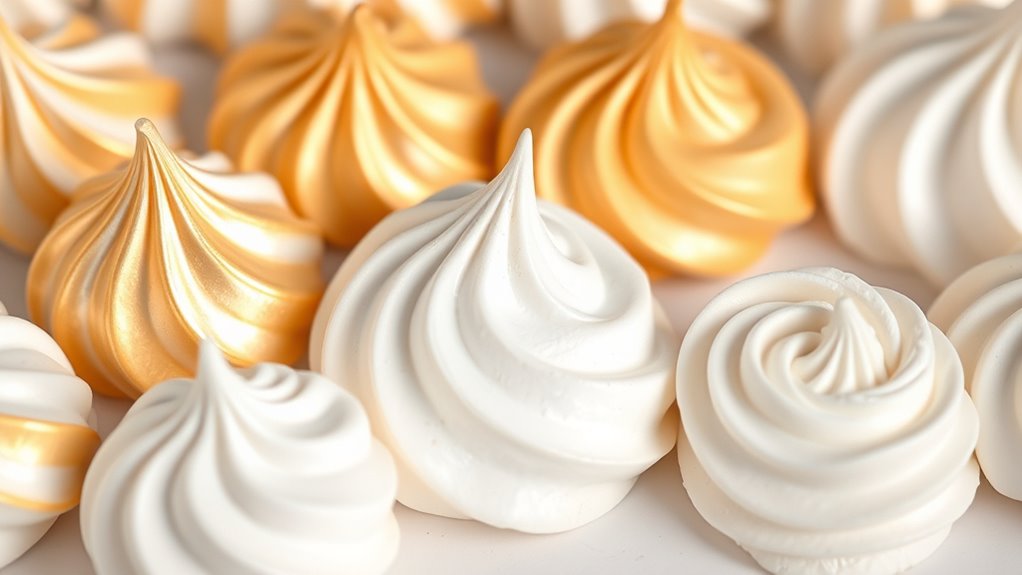
Understanding the basic components of meringue is essential to mastering its preparation. At its core, meringue relies on three main ingredients: egg whites, sugar, and an acid like cream of tartar or lemon juice. Egg whites are the foundation; they contain proteins that, when whipped, trap air and create volume. Sugar stabilizes the foam, giving it structure and shine. The acid helps strengthen the egg white proteins, making the meringue more stable and glossy. Properly combining these ingredients is key—you should beat the egg whites until soft peaks form before gradually adding sugar. Avoid overbeating, which can cause the mixture to become dry and lose volume. When you get these components right, you’ll create a firm, shiny meringue perfect for many desserts. Incorporating an acidic component like lemon juice can also enhance the stability and glossiness of the meringue. Additionally, the stability of the meringue depends on the correct balance of these ingredients and technique. Achieving the right texture requires careful attention to how long and vigorously you whip the mixture. Using a clean, dry mixing bowl can also help achieve optimal volume in your meringue. Proper technique is especially important to prevent weeping, which occurs when excess moisture escapes the meringue.
Soft Meringue: Texture and Uses

Soft meringue has a lighter, more delicate texture compared to its stiff counterpart, making it ideal for specific desserts. Its airy, smooth consistency melts easily in your mouth, offering a gentle sweetness. You’ll often find it as a topping or layer in pies, pavlovas, and chiffons. Its softness allows it to blend seamlessly into desserts without adding crunch or firmness. Use it when you want a tender, cloud-like finish that complements fruit or cream fillings. For those who appreciate preppy dog names, the same sense of refined elegance can be found in the delicate presentation of soft meringue desserts. Proper storage in airtight containers helps preserve its fragile structure and freshness. Keeping soft meringue refrigerated can also extend its shelf life, ensuring it remains light and fluffy for serving. Additionally, understanding the sound vibrations involved in food textures can help achieve the perfect consistency.
Stiff Meringue: Characteristics and Applications

Ever wonder what makes stiff meringue stand up so firmly? It’s the high volume of beaten egg whites combined with sugar, which stabilizes the foam structure. When you beat the whites to stiff peaks, the proteins form a strong network that can support weight and hold its shape. This type of meringue is less airy than soft meringue and has a glossy, firm texture. You’ll find it used in recipes like pavlovas, meringue shells, and baked toppings for pies. Stiff meringue also resists collapsing, making it ideal for sculptures or layered desserts. Its stability allows it to crisp up nicely when baked, creating a delicate, crunchy exterior while remaining chewy inside. Use stiff meringue when you need a sturdy, decorative, and long-lasting whipped topping.
Swiss Meringue: Method and Benefits

Swiss meringue is a smooth, glossy foam made by gently heating egg whites and sugar together over a double boiler before whipping. This method guarantees the sugar dissolves completely, reducing the risk of graininess and creating a silky texture. Once the mixture reaches about 160°F (70°C), you remove it from the heat and whip it at high speed until it forms stiff, shiny peaks. The benefits of Swiss meringue include its stability, which makes it ideal for frosting or filling cakes, and its smooth, velvety consistency. It’s also less sweet than other meringues, allowing the flavors of your dessert to shine through. Plus, the gentle heating process minimizes the risk of over-whipping or curdling, making it a reliable choice for beginners.
Italian Meringue: Technique and Popularity
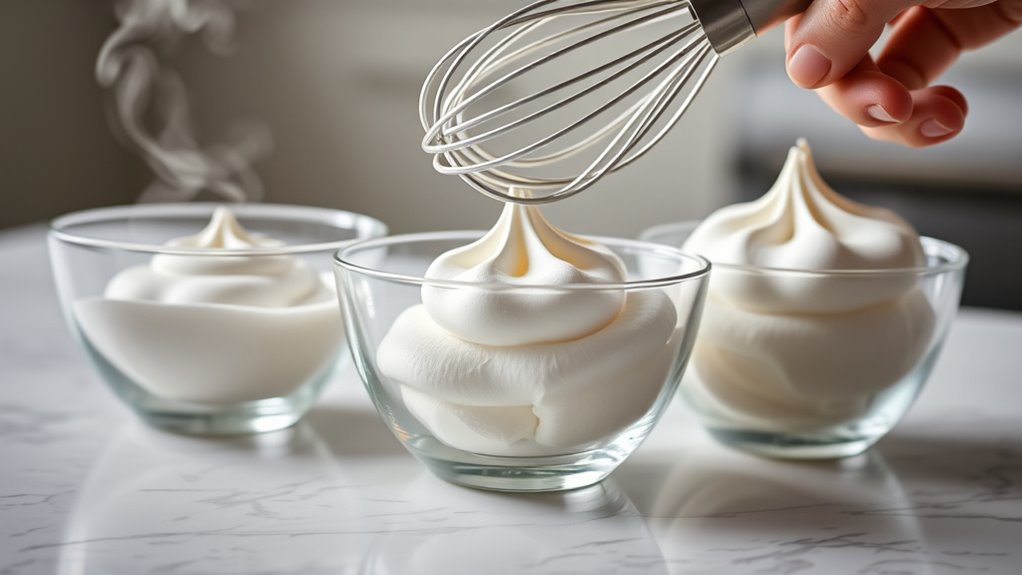
To master Italian meringue, you need to carefully temper the sugar to the right temperature, ensuring a smooth and stable mixture. Whipping it to the right consistency is essential for achieving the classic, glossy finish that makes it versatile. You’ll find Italian meringue popular in desserts like soufflés and buttercreams, where its stability and shine are prized.
Precise Sugar Tempering
Precise sugar tempering is essential to achieving the smooth, glossy texture characteristic of Italian meringue. You start by heating sugar and water to a specific temperature, usually around 240°F (115°C), ensuring the sugar dissolves completely without crystallizing. Using a candy thermometer helps you monitor this accurately. As the syrup reaches the right temperature, you must remove it from heat immediately to prevent overcooking. Pour the hot syrup slowly into whipped egg whites while constantly beating, controlling the flow to avoid splattering or cooking the eggs. This careful tempering creates a stable, glossy mixture with a silky texture. Proper temperature control and steady pouring are key to preventing graininess and ensuring your Italian meringue turns out smooth and shiny every time. Additionally, understanding the temperature range is crucial for achieving optimal results, and maintaining consistent whisking speed helps incorporate air evenly into the mixture. Ensuring the use of high-quality ingredients can also impact the final texture and appearance of your meringue.
Whipping Consistency Crucial
Once you’ve heated the sugar syrup to the right temperature and slowly poured it into your whipped egg whites, the next step is to focus on the consistency of your whipping. Achieving the perfect texture ensures the meringue holds its shape and stays stable. You’ll want your egg whites to reach a glossy, firm peak without over-whipping, which can cause them to become grainy or break down. Keep an eye on the mixture as it thickens and forms stiff peaks, indicating readiness. Proper whipping creates a silky, smooth meringue with a dense structure. Additionally, stability is key to preventing collapse or weeping in the finished meringue. Using the right mixing technique ensures the incorporation of air is even and the texture remains consistent throughout.
Classic Italian Uses
Have you ever wondered why Italian meringue is a favorite for many classic desserts? Its stability and glossy texture make it perfect for toppings and fillings. You’ll often find it in desserts like pavlova, layered cakes, and tarts. Its smooth, firm consistency holds up well even when exposed to heat or refrigeration. Additionally, the materials used in Italian meringue contribute to its durability and appealing appearance. The cookie categories involved ensure that it functions reliably across various dessert applications. Its compatibility with various ingredients is also enhanced by its emulsification properties, which improve its texture and stability. Embracing the principles of creative practice can inspire new ways to incorporate Italian meringue into innovative desserts.
Here’s a quick look at some popular uses:
| Classic Uses | Description |
|---|---|
| Topping for Pavlova | Adds a shiny, crisp shell and marshmallow interior |
| Cake Decorations | Holds shape well for piping intricate designs |
| Filling for Tarts | Combines stability with a light, airy texture |
| French Macarons | Used as a filling for delicate shells |
| Soufflés | Provides structure and a glossy finish |
Italian meringue’s versatility makes it a staple in many desserts.
How to Choose the Right Meringue for Your Recipe
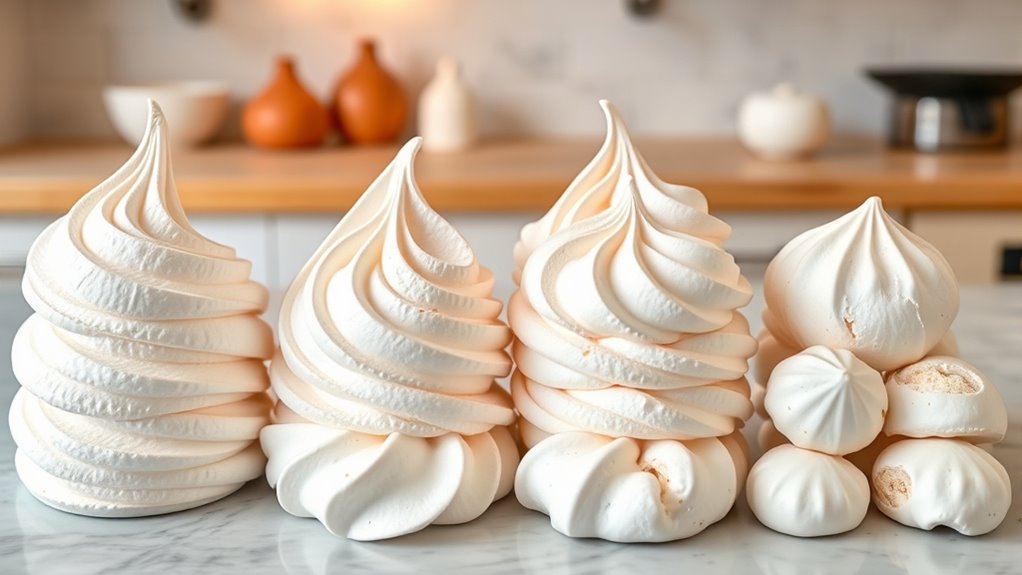
When selecting a meringue, consider the desired texture and how stable it needs to be for your recipe. Keep in mind that sugar and acid levels influence not only sweetness but also how well the meringue maintains its structure. Matching these factors ensures your dessert turns out just right. Additionally, understanding seasonal variations can help you choose the best type of meringue for different times of the year. For example, humidity levels can affect meringue stability, so adjusting techniques based on climatic conditions can lead to better results. Moreover, being aware of environmental factors such as humidity and temperature can help you select the most suitable meringue type for your environment. Recognizing product quality is also important, as fresh and high-quality ingredients can improve the final outcome.
Texture and Stability
Choosing the right meringue depends on its texture and stability, which directly affect how your final dessert turns out. A stable meringue holds its shape, providing structure, while a softer one creates a light, airy texture. When selecting, consider how the meringue interacts with your recipe. For instance, a firm meringue is ideal for pavlovas or baked shells, offering firmness and support. A softer meringue suits toppings or folding into whipped cream, adding delicacy.
- Firm, crisp exterior with a chewy center
- Light, airy, and delicate
- Stable enough to hold shape during baking
- Soft and marshmallow-like for folding or topping
Sugar and Acid Content
The amount of sugar and acid you add to your meringue directly influences its sweetness, stability, and texture. More sugar creates a sweeter, glossier meringue with a softer interior, but too much can weaken its structure. Acid, usually cream of tartar or lemon juice, helps stabilize the egg whites and achieve a firm, glossy finish. If you want a crisp, stiff meringue, use a small amount of acid and moderate sugar. For softer, chewy varieties, reduce acid and sugar slightly. Balancing these ingredients is key to matching your desired outcome. Remember, adding sugar gradually while beating helps achieve maximum volume and stability. Experimenting with sugar and acid levels allows you to customize your meringue for pies, pavlovas, or other desserts.
Tips for Perfecting Your Meringue
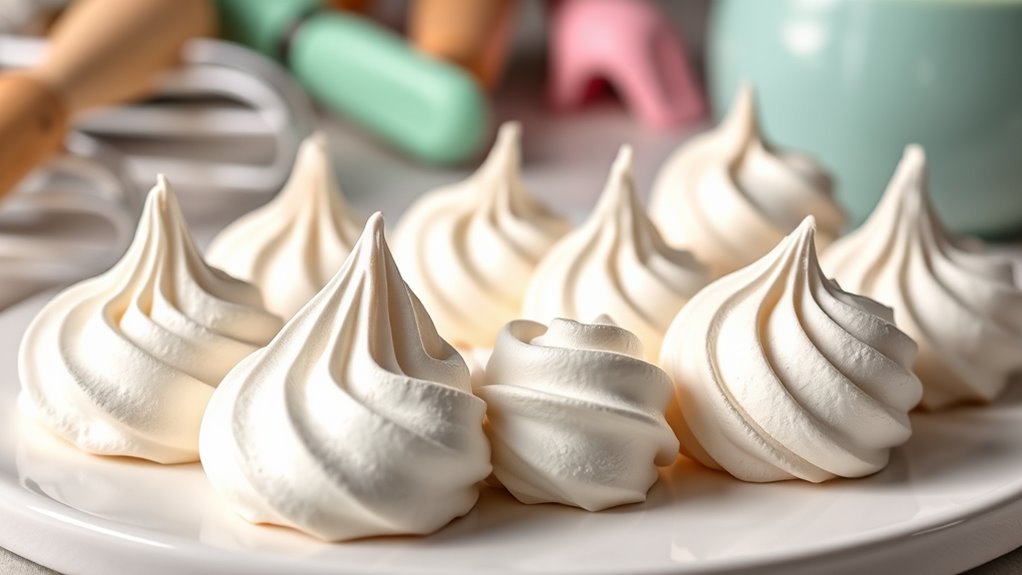
Achieving perfect meringue hinges on several key techniques that guarantee your peaks are stiff, glossy, and stable. First, use a clean, dry bowl and beaters to prevent any grease or moisture from weakening the foam. Second, add sugar gradually once soft peaks form, allowing it to dissolve completely for a smooth, stable meringue. Third, avoid over-beating, which can cause the meringue to become dry and grainy. Finally, incorporate a small amount of acid, like cream of tartar, to help stabilize the structure.
- Use fresh eggs at room temperature for better volume
- Incorporate sugar slowly and evenly
- Stop beating as soon as stiff, glossy peaks form
- Add stabilizers to enhance stability
Common Mistakes to Avoid When Making Meringue
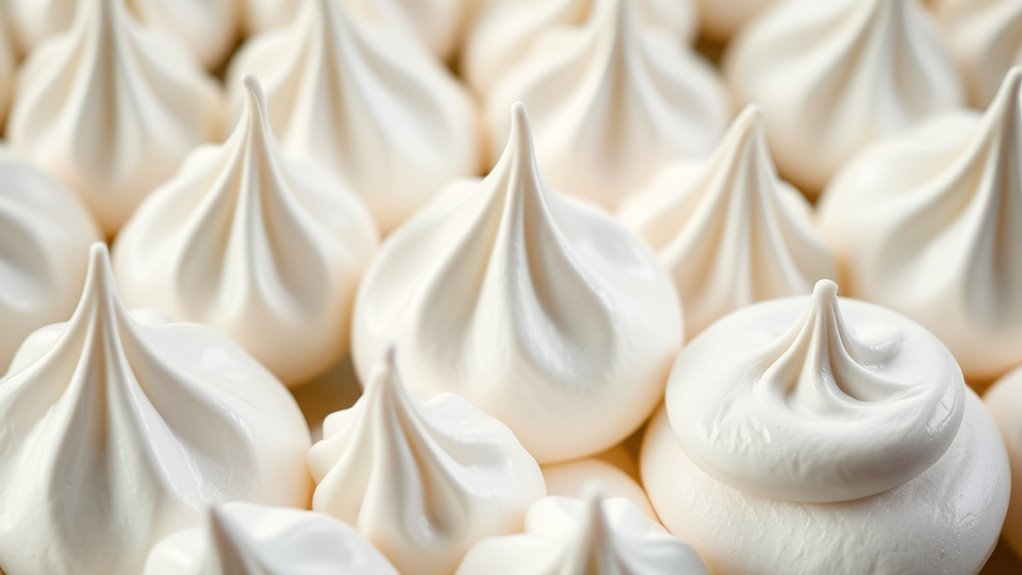
One common mistake is overbeating egg whites, which can cause them to become dry and lose volume. Using the wrong type of sugar, like superfine instead of granulated, can affect the meringue’s stability. Additionally, neglecting proper equipment, such as using a greasy bowl or plastic whisk, can prevent your meringue from forming correctly.
Overbeating Egg Whites
Overbeating egg whites can quickly ruin your meringue by making it coarse, dry, and difficult to work with. When you beat too long, the proteins tighten excessively, causing the foam to collapse or become grainy. You’ll notice it starts to look dry, with stiff peaks that are rough and lumpy instead of smooth and glossy. Overbeaten egg whites lose their airy, delicate texture, making it hard to fold in other ingredients or shape. To avoid this, watch for signs of readiness and stop when the peaks are just firm and shiny.
- Egg whites turn grainy and dry
- Peaks become stiff and lumpy
- Foam loses its shine and becomes dull
- The mixture becomes difficult to fold or spread
Using Wrong Sugar Type
Using the wrong type of sugar is a common mistake that can sabotage your meringue’s texture and stability. Regular granulated sugar is best because it dissolves easily and helps create a glossy, firm meringue. Using superfine sugar speeds up dissolving and results in a smoother texture, especially in whipped egg whites. Avoid powdered sugar, which contains cornstarch that can weaken the structure and cause a grainy or sticky meringue. Conversely, using coarse sugar makes it harder to dissolve completely, leading to a grainy or weepy meringue. Always choose the right sugar for your recipe to guarantee your meringue remains stable, shiny, and holds its shape. Correct sugar selection is essential for achieving the perfect, professional-looking meringue you’re aiming for.
Neglecting Proper Equipment
Choosing the right equipment is just as important as selecting the proper ingredients when making meringue. Using the wrong tools can lead to a failed batch or a less-than-perfect texture. You need a clean, dry mixing bowl—preferably glass or metal—free of grease or residue. A stand mixer or hand whisk is best for achieving stiff peaks efficiently. Make sure your beaters are spotless to prevent any grease from weakening the meringue. Additionally, use a spatula for gentle folding and avoid plastic bowls, which can retain oil and hinder proper whipping.
- Glass or metal mixing bowl, thoroughly cleaned
- Clean beaters or whisk attachment
- Spatula for folding
- No plastic bowls, as they can retain grease
Creative Ways to Use Different Types of Meringue

Once you’ve mastered making different types of meringue, the fun begins with exploring creative ways to incorporate them into your desserts. You can use crisp, Swiss or Italian meringue to top pies and tarts, adding a light, sweet layer that’s visually appealing. Fold meringue into mousse or cheesecake batters for airy textures. For a show-stopping effect, pipe piped meringue into shapes and bake into cookies or shells, perfect for filling with fruit or cream. Use meringue as a decorative element by torching the peaks for a brûléed finish or creating pavlovas that highlight fresh fruit. You can also layer meringue in parfaits or serve it as a delicate, crisp garnish. These ideas let you transform simple meringue into versatile, creative desserts.
Frequently Asked Questions
Can Meringue Be Made Gluten-Free?
Yes, you can make meringue gluten-free. Since traditional meringue mainly uses egg whites and sugar, it naturally contains no gluten. Just verify you’re using clean equipment and avoiding any added ingredients that might contain gluten. You can also add flavorings like vanilla or cocoa powder, but stick with pure, gluten-free ingredients. This way, you’ll enjoy a delicious, gluten-free meringue without any issues.
How Long Does Meringue Last Before It Weeps?
Meringue can last a few hours before it starts weeping, especially if kept at room temperature. To extend its freshness, store it in an airtight container and avoid humidity, which causes weeping. If you plan to serve it later, consider adding toppings just before serving. Keep in mind, the longer it sits, the more likely it is to weep, so aim to enjoy it within 24 hours for the best texture.
Is It Necessary to Use Fresh Eggs for Meringue?
You might think fresh eggs are a must for perfect meringue, but that’s not always the case. While fresh eggs can give you a little extra stability, older eggs tend to whip up fluffier, more voluminous meringue because of their lower water content. So, it’s not a dealbreaker, and you can still achieve great results with eggs that aren’t freshly laid, as long as they’re fresh enough to beat properly.
How Do Humidity Levels Affect Meringue Stability?
Humidity levels can considerably impact your meringue’s stability. When the air is humid, moisture gets absorbed into the meringue, making it sticky and prone to collapsing or weeping. To prevent this, you should work in a dry environment, use a dehumidifier if needed, and add sugar gradually. Also, avoid opening the oven door during baking, as humidity and temperature fluctuations can weaken your meringue’s structure.
Can Meringue Be Flavored or Colored Easily?
You can easily flavor or color meringue to suit your taste or theme. Adding a few drops of extract, like vanilla or almond, gives it a tasty boost, while food coloring can turn your meringue into a rainbow of shades. Just remember, a little goes a long way. Mixing gently prevents deflating your meringue, so you keep that perfect, airy texture. It’s a cakewalk to customize your treat!
Conclusion
Now that you’ve uncovered the secrets of meringue, you’re ready to dance with sugar and egg whites like a seasoned pastry artist. Think of each type as a different brushstroke on your baking canvas—soft, stiff, Swiss—each adding its unique flavor to your creations. With a little practice, you’ll turn simple ingredients into sweet symphonies that enchant the senses. So go ahead, let your baking adventures rise like a perfect meringue—light, airy, and utterly delightful.




